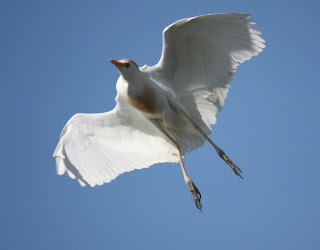
The original plannng was to go down to the Tarifa-La Janda area (Cádiz province) on New Year's mrning or very shortly thereafter and that trip did not take place until the morning of 30 April, something, dear readers, which you will have noted as being rather later than planned thanks to a multiplicity of reasons, including the weather or several occasions. And even now, two days later, I'm still wondering if it was worthwhile going!
I was at the hide on Los Lances beach, about half way up virtually opposite the petrol station by 0830. There have been huge changes, the board walk having been largely wiped out to large degree by the inclement weather, parts are wired off and there has been some scour along the high water line which also appears to have removed mud which is necessary for waders. In fact, apart from a few resting
Black-winged Stilts and about 10
Dunlins, one or two
Kentish Plovers and a single
Ringed Plover, that was the lot except for 3 rather hung-over looking
Yellow-legged Gulls. No terns, nothing moving over the sea, no Yellow Wagtails and only a couple of
Short-toed Larks and one or two
Crested Larks on what, if this was Scotland, I would call the machair.

Second stop, Bolonia and the swift cave. Swifts? What swifts? A few high fliers of indeterminate species but certainly not Little or White-rumped and a few
Crag Martins going in and out. A couple of male
Blue Rock Thrushes were having a bit of dust-up on the cliff top and a
Griffon Vulture was sitting on the usual nest. A
Great Spotted Woodpecker was calling somewhere below but it wasn't until I went back down towards Bolonia and stopped to have a look at the Egyptian Vulture site that it decided to appear and have a brief go at drilling a telegraph pole. One
Egyptian Vulture took off and showed quite nicely, as did a pair of
Short-toed Eagles - the only ones I saw all day - and a single
Booted Eagle. Third stop, a brief one for a much needed coffee and a
tostada at the bar at San José del Valle where a decapped/beheaded palm had a
White Stork standing on top and wondering if it could be made into a desirable residence.
After that it was La Janda, an area that is usually fairly fruitful but not today. Occasional
White Storks and both
Little and
Cattle Egrets plus tons of agricultural vehicles working to prepare for rice or whatever is giving the best EU subsidies this year.

The track along by the canal is perfectly passable and there were plenty of
Goldfinches and
House Sparrows, one or two singing
Sedge Warblers but not a single Great Reed with its raucous
swee-swee-churr-churr-honk-honk song(?). Was it too early for them or had the reed growth taken too much of a battering? The photo of the
Corn Bunting was taken through the car window and for once the thing sat instead of flying as soon as it realised that it was going to be photographed. No Montagu's Harriers to be seen all day and a single immature female
Marsh Harrier, plus some 50+
Black Kites as I went down and across the top to wards Benalup where there was another
Booted Eagle and one of the two
Kestrels seen all day.

On the plus side, there were good numbers of
Turtle Doves along the section after the bridge across the canal. So, not really a brilliant day's birding, in fact, far from it. But that's the way it goes.I shall go down again in a couple of weeks if there is time between going to Daimiel this week, Madeira mid month and the last week in Asturias.
Oh yes, and the book is finished!!!!












